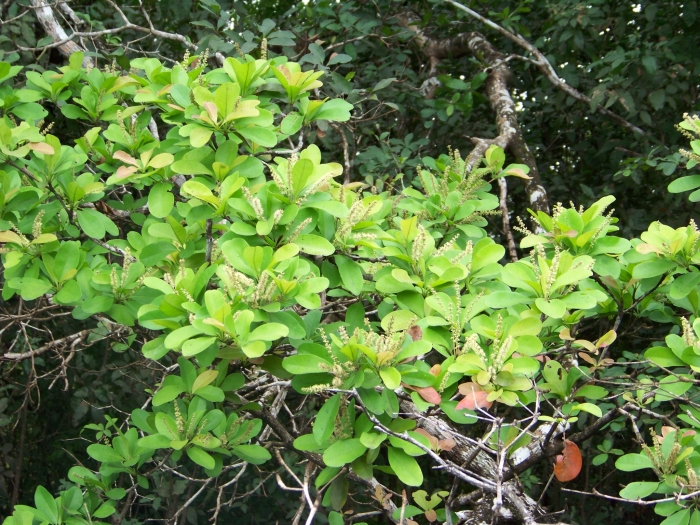Bullet Tree
(Terminalia buceras)
Bullet Tree (Terminalia buceras)
/
/

botanygirl
CC BY 4.0
Image By:
botanygirl
Recorded By:
Copyright:
CC BY 4.0
Copyright Notice:
Photo by: botanygirl | License Type: CC BY 4.0 | License URL: http://creativecommons.org/licenses/by/4.0/ | Rights Holder: botanygirl | Publisher: iNaturalist | Date Created: 2013-02-02T05:48:08-08:00 |
























Estimated Native Range
Summary
Terminalia buceras, commonly known as the bullet tree or black olive tree, is a semi-deciduous tree native to a variety of habitats, including tropical dry forests, coastal swamps, and wet inland forests at low elevations in Mexico, Central America, the Caribbean, and northern South America. It typically grows to a height of 40-50 feet (12-15 meters) with a canopy spread of 30-40 feet (9-12 meters). The tree has a dense, rounded crown and a straight, cylindrical trunk with gray to brown bark. The leaves are glossy green, and the small, inconspicuous white flowers bloom in clusters, followed by olive-like fruits that attract wildlife.
The bullet tree is valued for its hard and durable wood, which is used for construction purposes such as house posts and bridge timbers. Its bark, rich in tannins, is utilized for tanning leather. In cultivation, it serves as an ornamental and shade tree, appreciated for its dense canopy and tolerance to a range of soil conditions, though it prefers rich, moist, well-drained soils. It thrives in full sun and is suitable for urban planting, especially in tropical and subtropical regions. While generally low-maintenance, it can be susceptible to pests like borers and diseases such as leaf spot.CC BY-SA 4.0
The bullet tree is valued for its hard and durable wood, which is used for construction purposes such as house posts and bridge timbers. Its bark, rich in tannins, is utilized for tanning leather. In cultivation, it serves as an ornamental and shade tree, appreciated for its dense canopy and tolerance to a range of soil conditions, though it prefers rich, moist, well-drained soils. It thrives in full sun and is suitable for urban planting, especially in tropical and subtropical regions. While generally low-maintenance, it can be susceptible to pests like borers and diseases such as leaf spot.CC BY-SA 4.0
Plant Description
- Plant Type: Tree
- Height: 50-80 feet
- Width: 50-80 feet
- Growth Rate: Moderate
- Flower Color: Cream
- Flowering Season: Spring, Summer
- Leaf Retention: Deciduous
Growth Requirements
- Sun: Full Sun
- Water: Medium
- Drainage: Medium, Fast
Common Uses
Low Maintenance, Street Planting
Natural Habitat
Native to tropical dry forests, coastal swamps, and wet inland forests at low elevations
Other Names
Common Names: Almond Tree, Sea Almond, Gregory Wood, Ucar, Water Gregre, Gregorywood Tree, Indian Almond
Scientific Names: , Terminalia buceras, Buceras buceras, Buceras bucida, Bucida buceras, Bucida ophiticola, Bucida palustris, Bucida subinermis, Myrobalanus buceras, Terminalia buceras,
GBIF Accepted Name: